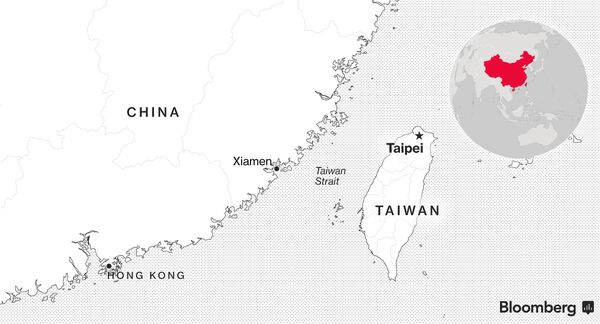China is ratcheting up the risk of military confrontation in the Taiwan Strait, as Beijing seeks to deter Taipei from continuing to deepen ties with the U.S. and other like-minded democracies.
People’s Liberation Army aircraft repeatedly breached the median line between Taiwan and the Chinese mainland last week, in the latest of a series of military exercises in the area. The Chinese pilots signaled a willingness to continue the practice, telling Taiwanese personnel who attempted to warn them away that “there is no median line,” the Taipei-based China Times newspaper reported Friday, citing unnamed military officials.
The report was widely circulated by Chinese state media, with the PLA’s Eastern Theater Command responding to one post by urging citizens to “discard any illusions and prepare to fight.” The PLA Air Force separately released a video Saturday showing H-6 bombers making a simulated strike on a runway that looked similar to one at Anderson Air Force Base on Guam, a key staging area for any U.S. support for Taiwan.
“The risks of war are rising considerably, and redrawing the map over the median line in the Taiwan Strait is a very obvious step by Beijing to not only raise the pressure, but also justify use of force,” said Malcolm Davis, a former defense adviser to the government and now a senior analyst at the Australian Strategic Policy Institute in Canberra. “These aggressive probes are perhaps designed to provoke the Taiwanese air force to ‘shoot first’ and then Beijing has all the justification it needs.”
Taiwanese President Tsai Ing-wen hosted a senior U.S. diplomat and a Japanese delegation in Taipei last week in the latest show of international support for her government. The officials attended the funeral Saturday of Taiwan’s first democratically elected president, Lee Teng-hui, whose policies toward Beijing were at the center of the last big military showdown between China and the U.S. in the strait in the late 1990s.
Beijing regards the island as part of its territory, and reserves the right to annex it by force, even though the two sides have been ruled separately for more than 70 years and have deep social and economic ties. Tsai, who views Taiwan as a sovereign nation, has courted greater U.S. military and economic support since her election in 2016.
The incursions across the median line, which the U.S. established in 1954 to prevent a conflict, signal Chinese President Xi Jinping’s displeasure with Trump administration overtures to Taiwan, including the visit last week by U.S. Undersecretary of State Keith Krach. Nineteen Chinese warplanes, including fighter jets and bombers, crossed the center line Saturday, according to Taiwan’s defense ministry.
Taiwan scrambled fighters and deployed an air-defense missile system, following similar action the prior day. Chinese military aircraft have crossed the median line five times since March 2019, after respecting the buffer zone for two decades. No planes breached the boundary Sunday after Krach’s departure.
Chinese Foreign Ministry spokesman Wang Wenbin told a regular news briefing Monday that there “is no so-called median line.” He vowed “countermeasures” against U.S. officials involved in the “political provocation” of visiting Taipei.

“These actions don’t help China’s international image, and they also put the Taiwanese public even more on their guard. They make the public better understand the true nature of the Chinese Communist regime and make other countries in the region understand the threat China poses,” Tsai told reporters Sunday. “The Chinese Communists must restrain themselves, and not provoke.”
The Japanese delegation to Lee’s funeral was led by former Japanese Prime Minister Yoshiro Mori, who conveyed Yoshihide Suga’s wishes for “smooth and peaceful” relations with Taiwan. The Dalai Lama, who China views as a separatist leader, also paid his respects via video to Lee, who died in July.
China’s “scenario-based” military exercises in the Taiwan Strait were intended to promote the country’s “security and sovereignty,” Senior Colonel Ren Guoqiang, a Defense Ministry spokesman, told reporters Friday in Beijing. Ren blamed U.S. and Taiwan for “frequently stirring up trouble.”
The Communist Party’s Global Times newspaper went further, warning in a tweet that the Taiwan side was “playing with fire.” Tsai “will be wiped out,” if she violated a 2005 Chinese law barring Taiwan from taking formal steps toward independence, the newspaper said.
Such military incursions can help planners learn about a target’s defense capabilities, divert attention from an actual strike or put political pressure on a rival. For Xi, they also serve to galvanizing domestic public opinion around his leadership at a time of economic and geopolitical unease.
Tsai has so far sought to avoid any actions that could provide Xi a pretense for an attack. Su Tzu-yun, a research fellow at the Institute for National Defense and Security Research in Taipei, said the incursions were aimed at whipping up nationalistic fervor at home.
“Beijing manipulates nationalism. Especially in the face of internal contradictions, nationalism can shift the focus and pressure,” Su said. “There is a greater risk of escalation and a military confrontation occurring, but currently it doesn’t benefit Beijing to do so.”
No comments:
Post a Comment